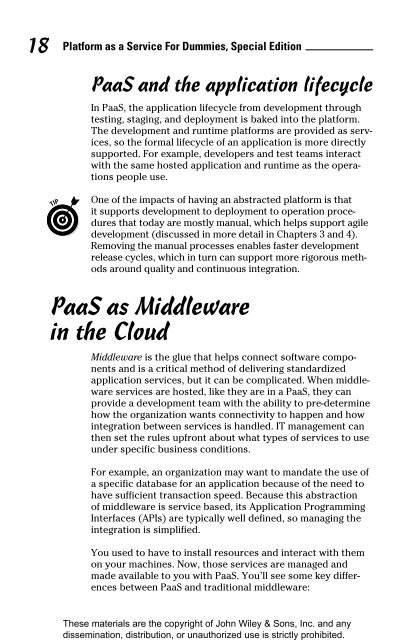u3Zgz
u3Zgz
u3Zgz
You also want an ePaper? Increase the reach of your titles
YUMPU automatically turns print PDFs into web optimized ePapers that Google loves.
These materials are the copyright of John Wiley & Sons, Inc. and any<br />
dissemination, distribution, or unauthorized use is strictly prohibited.<br />
18<br />
Platform as a Service For Dummies, Special Edition<br />
PaaS and the application lifecycle<br />
In PaaS, the application lifecycle from development through<br />
testing, staging, and deployment is baked into the platform.<br />
The development and runtime platforms are provided as services,<br />
so the formal lifecycle of an application is more directly<br />
supported. For example, developers and test teams interact<br />
with the same hosted application and runtime as the operations<br />
people use.<br />
One of the impacts of having an abstracted platform is that<br />
it supports development to deployment to operation procedures<br />
that today are mostly manual, which helps support agile<br />
development (discussed in more detail in Chapters 3 and 4).<br />
Removing the manual processes enables faster development<br />
release cycles, which in turn can support more rigorous methods<br />
around quality and continuous integration.<br />
PaaS as Middleware<br />
in the Cloud<br />
Middleware is the glue that helps connect software components<br />
and is a critical method of delivering standardized<br />
application services, but it can be complicated. When middleware<br />
services are hosted, like they are in a PaaS, they can<br />
provide a development team with the ability to pre-determine<br />
how the organization wants connectivity to happen and how<br />
integration between services is handled. IT management can<br />
then set the rules upfront about what types of services to use<br />
under specific business conditions.<br />
For example, an organization may want to mandate the use of<br />
a specific database for an application because of the need to<br />
have sufficient transaction speed. Because this abstraction<br />
of middleware is service based, its Application Programming<br />
Interfaces (APIs) are typically well defined, so managing the<br />
integration is simplified.<br />
You used to have to install resources and interact with them<br />
on your machines. Now, those services are managed and<br />
made available to you with PaaS. You’ll see some key differences<br />
between PaaS and traditional middleware:


